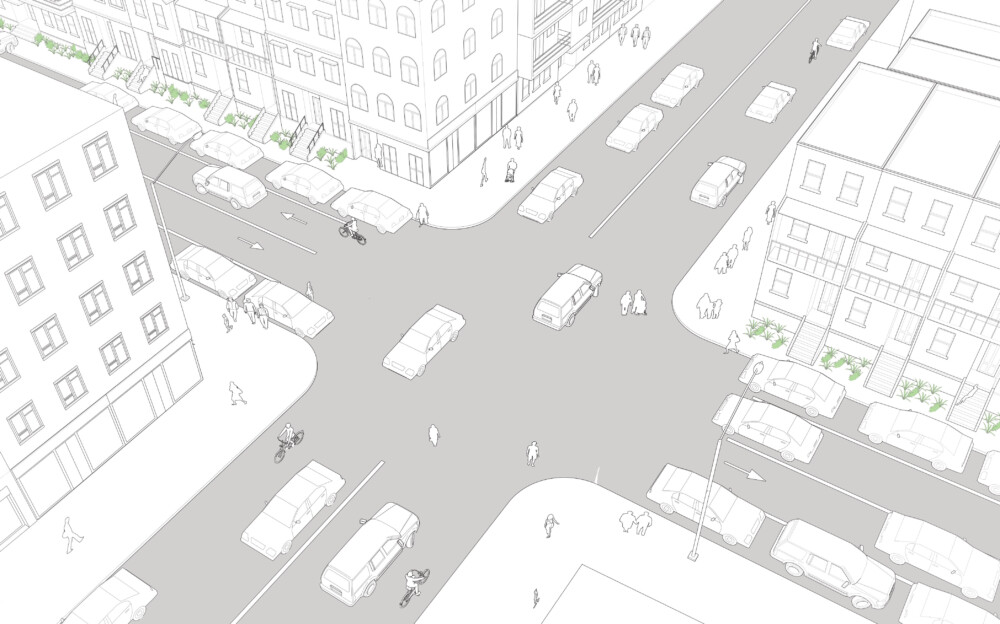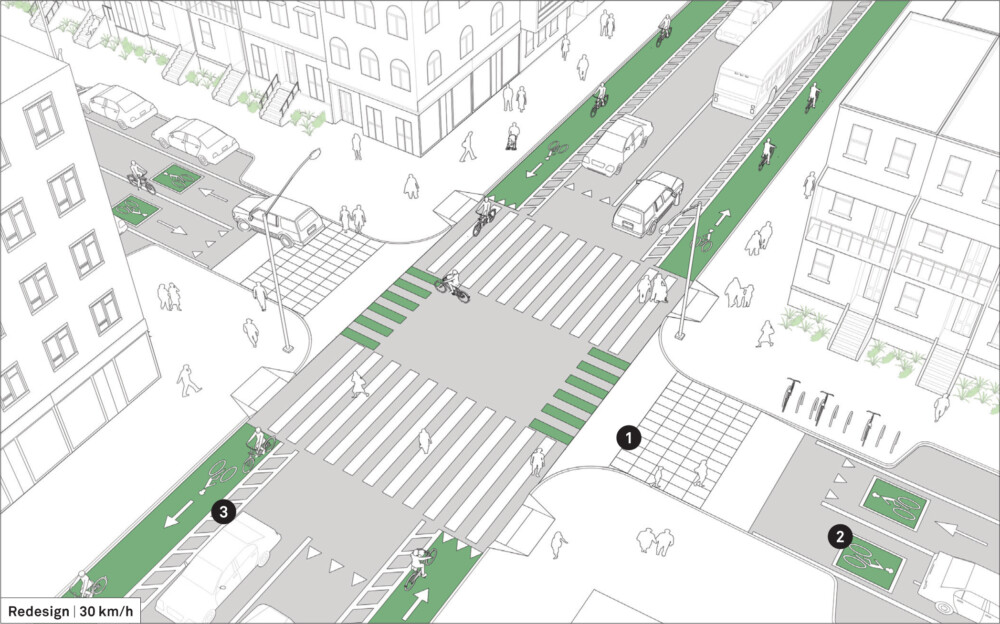-
About Streets
- Introduction
- Defining Streets
-
Shaping Streets
- The Process of Shaping Streets
- Aligning with City and Regional Agendas
- Involving the Right Stakeholders
- Setting a Project Vision
- Communication and Engagement
- Costs and Budgets
- Phasing and Interim Strategies
- Coordination and Project Management
- Implementation and Materials
- Management
- Maintenance
- Institutionalizing Change
- Measuring and Evaluating Streets
-
Street Design Guidance
- Designing Streets for Great Cities
- Designing Streets for Place
-
Designing Streets for People
- Utilities and Infrastructure
- Operational and Management Strategies
- Design Controls
-
Street Transformations
- Streets
-
Intersections
- Intersection Design Strategies
- Intersection Analysis
- Intersection Redesign
- Mini Roundabout
- Small Raised Intersection
- Neighborhood Gateway Intersection
- Intersection of Two-Way and One-Way Streets
- Major Intersection: Reclaiming the Corners
- Major Intersection: Squaring the Circle
- Major Intersection: Cycle Protection
- Complex Intersection: Adding Public Plazas
- Complex Intersection: Improving Traffic Circles
- Complex Intersection: Increasing Permeability
- Resources
Global Street Design Guide
-
About Streets
- Introduction
- Defining Streets
-
Shaping Streets
Back Shaping Streets
- The Process of Shaping Streets
- Aligning with City and Regional Agendas
- Involving the Right Stakeholders
- Setting a Project Vision
- Communication and Engagement
- Costs and Budgets
- Phasing and Interim Strategies
- Coordination and Project Management
- Implementation and Materials
- Management
- Maintenance
- Institutionalizing Change
-
Measuring and Evaluating Streets
Back Measuring and Evaluating Streets
-
Street Design Guidance
-
Designing Streets for Great Cities
Back Designing Streets for Great Cities
-
Designing Streets for Place
Back Designing Streets for Place
-
Designing Streets for People
Back Designing Streets for People
- Comparing Street Users
- A Variety of Street Users
-
Designing for Pedestrians
Back Designing for Pedestrians
- Designing for Cyclists
-
Designing for Transit Riders
Back Designing for Transit Riders
- Overview
- Transit Networks
- Transit Toolbox
-
Transit Facilities
Back Transit Facilities
-
Transit Stops
Back Transit Stops
-
Additional Guidance
Back Additional Guidance
-
Designing for Motorists
Back Designing for Motorists
-
Designing for Freight and Service Operators
Back Designing for Freight and Service Operators
-
Designing for People Doing Business
Back Designing for People Doing Business
-
Utilities and Infrastructure
Back Utilities and Infrastructure
- Utilities
-
Green Infrastructure and Stormwater Management
Back Green Infrastructure and Stormwater Management
-
Lighting and Technology
Back Lighting and Technology
-
Operational and Management Strategies
Back Operational and Management Strategies
- Design Controls
-
Street Transformations
-
Streets
Back Streets
- Street Design Strategies
- Street Typologies
-
Pedestrian-Priority Spaces
Back Pedestrian-Priority Spaces
-
Pedestrian-Only Streets
Back Pedestrian-Only Streets
-
Laneways and Alleys
Back Laneways and Alleys
- Parklets
-
Pedestrian Plazas
Back Pedestrian Plazas
-
Pedestrian-Only Streets
-
Shared Streets
Back Shared Streets
-
Commercial Shared Streets
Back Commercial Shared Streets
-
Residential Shared Streets
Back Residential Shared Streets
-
Commercial Shared Streets
-
Neighborhood Streets
Back Neighborhood Streets
-
Residential Streets
Back Residential Streets
-
Neighborhood Main Streets
Back Neighborhood Main Streets
-
Residential Streets
-
Avenues and Boulevards
Back Avenues and Boulevards
-
Central One-Way Streets
Back Central One-Way Streets
-
Central Two-Way Streets
Back Central Two-Way Streets
- Transit Streets
-
Large Streets with Transit
Back Large Streets with Transit
- Grand Streets
-
Central One-Way Streets
-
Special Conditions
Back Special Conditions
-
Elevated Structure Improvement
Back Elevated Structure Improvement
-
Elevated Structure Removal
Back Elevated Structure Removal
-
Streets to Streams
Back Streets to Streams
-
Temporary Street Closures
Back Temporary Street Closures
-
Post-Industrial Revitalization
Back Post-Industrial Revitalization
-
Waterfront and Parkside Streets
Back Waterfront and Parkside Streets
-
Historic Streets
Back Historic Streets
-
Elevated Structure Improvement
-
Streets in Informal Areas
Back Streets in Informal Areas
-
Intersections
Back Intersections
- Intersection Design Strategies
- Intersection Analysis
- Intersection Redesign
- Mini Roundabout
- Small Raised Intersection
- Neighborhood Gateway Intersection
- Intersection of Two-Way and One-Way Streets
- Major Intersection: Reclaiming the Corners
- Major Intersection: Squaring the Circle
- Major Intersection: Cycle Protection
- Complex Intersection: Adding Public Plazas
- Complex Intersection: Improving Traffic Circles
- Complex Intersection: Increasing Permeability
- Resources
- Guides & Publications
- Global Street Design Guide
- Intersections
- Neighborhood Gateway Intersection
Neighborhood Gateway Intersection
Intersections of streets of different scales often lack the same level of definition, safety, and clarity as same-scale intersections. Where narrow streets meet larger streets, define the transition and context by using gateway treatments such as curb extensions, raised crossings, and small corner radii. Use these design elements so that people turning onto the narrower street become aware of entering a slow-speed environment.


Existing Conditions
This illustration depicts a two-way thoroughfare intersecting a residential two-way street.
Recessed pedestrian crossings increase the walking distances for pedestrians, who tend to cross at non-marked locations. While each street plays a different role at the network level, their hierarchy is unclear at the intersection.
Vehicles parked at the intersection on the residential street obstruct mutual visibility between motorists and pedestrians. The pedestrians have to step onto the roadbed to see if a vehicle is coming, and to be seen by drivers.
On the larger street, cyclists and pedestrians, though legally permitted to cross, are implicitly discouraged from doing so by design. Vehicles often fail to yield at these locations and have few design cues to suggest they should.
Design Guidance
This reconstruction establishes a clear hierarchy between the two streets, taking into consideration all users and the role of each street within the larger network.
![]() Raise the pedestrian crossings at the entrances to residential streets to prevent motorists from speeding when entering the street. This prioritizes pedestrian safety and increases legibility.
Raise the pedestrian crossings at the entrances to residential streets to prevent motorists from speeding when entering the street. This prioritizes pedestrian safety and increases legibility.
![]() Introduce shared-lane markings and advanced stop boxes to prioritize cyclists at the intersection. A maximum speed of 30 km/h is recommended on the residential street and the use of traffic calming measures is encouraged.
Introduce shared-lane markings and advanced stop boxes to prioritize cyclists at the intersection. A maximum speed of 30 km/h is recommended on the residential street and the use of traffic calming measures is encouraged.
![]() Add buffered cycle lanes on wider streets to create a safer environment for cyclists.
Add buffered cycle lanes on wider streets to create a safer environment for cyclists.
Install curb extensions onto the smaller streets to reduce pedestrian crossing length, protect pedestrians, and prevent motorists from parking at the intersection corners.
Utilize these curb extensions for cycle parking, green infrastructure, and street furniture.

Fortaleza, Brazil
Adapted by Global Street Design Guide published by Island Press.
Next Section —